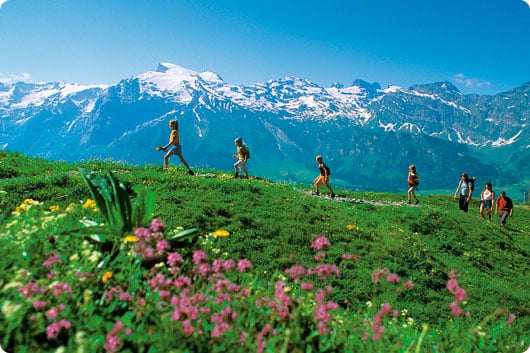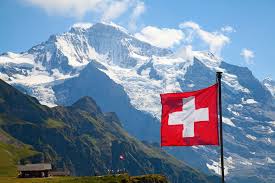
By Elyse Glickman
 For the Jewish traveler, modern Switzerland holds many wonderful surprises, especially when it comes to its Jewish community and culture. One of the most surprising and emotionally powerful is that back on August 29, 1897, the seeds for the future state of Israel were planted under the leadership of journalist, writer and political activist Theodore Herzl at the First Zionist Congress held in Basel.
For the Jewish traveler, modern Switzerland holds many wonderful surprises, especially when it comes to its Jewish community and culture. One of the most surprising and emotionally powerful is that back on August 29, 1897, the seeds for the future state of Israel were planted under the leadership of journalist, writer and political activist Theodore Herzl at the First Zionist Congress held in Basel.
Travelers exploring Jewish history in Switzerland need to take the bad with the good, as Swiss history shares many parallels with other European countries. In many centers like Basel and Zurich, Jews endured second-class citizen status, vocational restrictions, expulsions, persecution and pogroms; expulsions and religious discrimination occurred there from the Middle Ages through the 19th century. However, Switzerland is also a country known for important human rights milestones and bringing about sweeping change, starting with the Great Council of Helvetia (1798-99, when Switzerland’s most liberal citizens advocated civic equality for the Jews and attacked the ancient prejudices of intolerance) and the 1874 Federal Constitution, which granted civic equality for Jewish residents.
Today, various Swiss Jewish populations are well united under the auspices of The Swiss Federation of Jewish Communities, which oversees the interests of 23 different organizations. Jews who resided in or spent considerable time in Switzerland include Chaim Weizmann (the first president of Israel), Albert Einstein (who spent much of his youth in Switzerland), Marc Chagall, Yehudi Menuhin and Ruth Dreifuss, who became Switzerland’s first woman president.
A Jewish Tour of Basel
Prior to starting my guided tour of Jewish sights in Basel, which we began at the Basel Hilton (which has a superb program for guests keeping kosher), my Basel Tourism guide Armgarde Sasse showed me a rare brochure published in 1997 providing comprehensive information for Jewish and Kosher travelers coming to celebrate the centennial of the First Zionist Congress.
According to Sasse, generations of Jews were required to live outside Basel’s city walls and were restricted to the money-lending trade. One famous gate leading into the present-day central business district once featured a plaque from the early 18th century, listing entry tolls and a warning that Jews had to be out of the city when a loud curfew bell was rung.
Although there’s no definitive Jewish quarter, we began at Basel’s Great Synagogue and walked to Israel Park, a grove of 40 trees presented to Basel by Israel President Chaim Herzog, and to Switzerland’s only Jewish Museum, which is small in size, but rich in artifacts and history.
We also visited Kunstmuseum Basel, which features five of Marc Chagall’s revered studies of four rabbis, a moving portrait of his wife Bella and an idiosyncratic self-portrait.
On to Zurich
Zurich is home to nearly half of Switzerland’s estimated 6,800 Jews, and has been for centuries, so an exploration this thriving city is particularly fulfilling.
After an elegant lunch at Olive Garden, the fine-dining restaurant at the Israelitische Cultusgemeinde Zürich (the Swiss equivalent of the Jewish Community Center), my guide Elisabeth Brem led me through Old Zurich to Blue Note Music Store , which was once a synagogue in the heart of the former Judengasse —a thriving community ultimately eradicated during the Protestant reform movement led by John Calvin.
Nearby, we go inside an apartment whose hallway reveals a mural from the 1330s depicting Jews living well, dancing and displaying family crests of relatives and friends in their homes.
We also saw many modern signposts to Jewish/Christian co-existence, from Marc Chagall’s five stained glass windows at Cathedral Frauenmünster and other works on display in the Kunsthaus Zurich Museum to the flagship location of Hiltl, the famed vegetarian restaurant that has been a popular hangout for generations of local Jews who are not orthodox but maintain a kosher-style diet. While not officially certified kosher, it’s been serving Zurich Jews since 1898.
Geneva’s Jewish Gems
Many of Geneva’s luxury hotels, including Le Richemond and Le Beau-Rivage, offer impressive kosher programs, making them a perfect home base for our Jewish city tour. We started out at La Grande Synagogue, Geneva’s first major synagogue, constructed in the 1850s after the Swiss government granted religious freedom for all in 1847. Now known as Beth Yaacov, it is a beautiful structure. Then it was on to Carrouge, a one-time Jewish enclave where you you can still visit the Jewish cemetery. We made sure to look closely at the Gare de Cornavin, the city’s main train station on the left bank of Lake Geneva, a beautiful example of Art Deco architecture designed by the Geneva-born Jewish architect Julien Flegenheimer.
To round out our tour, we headed to Macom, Geneva’s principal Jewish community center, which offers a sanctuary, a main Jewish library and Le Jardin kosher restaurant – and the place where we toasted the end of our fascinating Jewish tourist experience in Switzerland. L’Chaim!